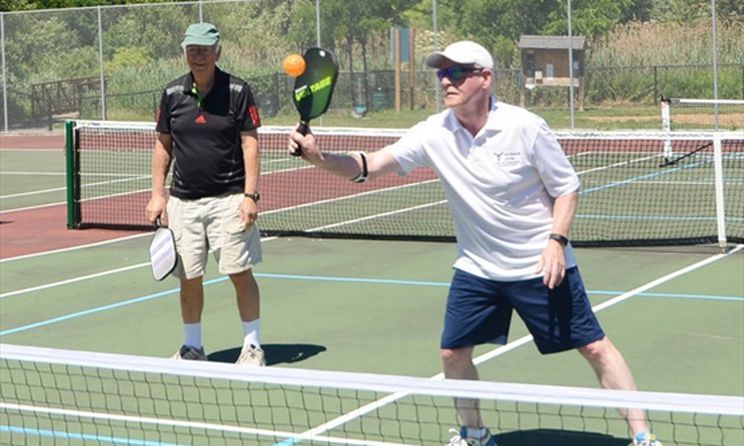Keys to Improvement 2022
Coach Dave: “Use the warm up to practice a variety of shots if you are not going to routinely drill. In rec games focus more on proper shot selection and execution rather than winning with the wrong shots. Failure to practice the proper shots will develop bad habits and psychologically you won’t be prepared to execute the proper shots against higher level /better players.”
Basic Serve: Deep (last 3rd of the court). Work on targeting left/middle/right side of court. Don’t be afraid to vary the speed of your serves but keep them in. AVOID excessive spin – a higher level player will return your serve no matter what. Goal: force a weak return but keep the ball in.
Return of Serve: Deep (last 3rd of court). Center or slightly off center. Slice return is generally more common than a topspin return (ie: drive), experiment with variety. Goal: get to the NVZ. Keep the return in and the serving team back making the 3rd shot more difficult. DO NOT get fancy – the faster/harder you return = less time to get to NVZ.
ANYTIME your team is not at the NVZ (first instance is as serving team) use the drop. Goal: Force your opponents to hit up on the ball. Perfect the drop from all positions behind the NVZ. The drop is not guaranteed to result in a dink so be prepared to execute it as many times as it takes to inch up to the NVZ.
The game is played at the NVZ. Always work on error free dinks – these shots are a staple of the game. Goal: perfect your dinks. Attack a ball you can hit down on targeting empty space, feet and/or dominant side of body, but keep it in the court.
Patience is loosely defined. Broadly speaking it is taking the time to wait for an opportunity to be more aggressive. Being aggressive starts with you being in the proper position – NOT stretched or moving. The ball must be above knee level (or higher) and within your capabilities to clear the net.
Two main points: Apply the 90% rule – if a ball is not within 90% of being the perfect ball to be aggressive with, dink and have patience until you get that ball.
Point 2: NEVER hit so hard that the trajectory of the ball will let it go off the court.
Volleys: PRACTICE them. Volley drops might be slightly more difficult than the 3rd shot drop but too many players let the ball bounce when they should have volleyed. Both while progressing up to the NVZ and while dinking at the NVZ. Practice volleys.
PRACTICE NOT HITTING HARD: A very high percentage of unforced errors are caused by simply hitting the ball harder than the circumstances required. Example: keeping the serving team back simply requires deep well-placed shots. Hard and fast shots are NOT required and exponentially increase your room for error.
Backhand: If it is weak DO NOT make allowances for it by allowing your partner to cover for you or move to take shots on your forehand. In rec games practice your backhand shots until you are as comfortable with them as your forehand. A 3.5 player needs to demonstrate 6/10 backhand drops – practice.
Learning Opportunities: Take them. Goal: become a better player.
If playing against opponents with one really good player with a weaker partner don’t just target the weaker player in the hopes of a ‘hollow’ victory. Play the stronger player to test your skills and observe what they can do.
You will improve as a player and that stronger player might just come back to play rather than seek games elsewhere that offer more inclusive play.
Every sport has its nuances, nothing is ever black and white. However, the concepts above, if applied diligently and with purpose, will not fail to improve your game. Focus less on winning a rec game and apply yourself to improving as a player. Winning will follow!






